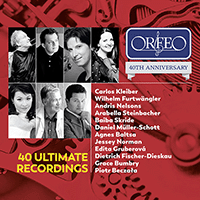Lamberto Gardelli
Lamberto Gardelli’s first public appearance was as a pianist when he was only eight years old. While a student at the Liceo Musicale Rossini in Pesaro he formed a student orchestra, going on to study in Rome where he was a composition pupil of Goffredo Petrassi. Soon he was acting as an accompanist to singers such as Gigli, Schipa and Cigna; coaching at the Rome Opera House; and was taken on by Tullio Serafin as an assistant, starting as a prompter. Gardelli also worked with composers such as Giordano, Mascagni, Pizzetti and Zandonai, as well as Petrassi. He made his conducting debut in 1944 in Rome with Verdi’s La traviata and two years later became resident conductor at the Royal Swedish Opera in Stockholm. Here he specialised in the Italian and contemporary repertoires, staying until 1955 and becoming a Swedish citizen. Between 1955 and 1961 Gardelli was permanent conductor of the Danish National Radio Symphony Orchestra, appearing also frequently in Berlin (at the Staatsoper), and in Helsinki. In 1961 he was appointed as chief conductor of the Hungarian National Opera, and although he relinquished this post in 1965 he remained active with the company, as well as with other Hungarian musical organisations such as the Budapest Philharmonic Orchestra, right up to the last years of his life. Gardelli also recorded extensively for the Hungarian record company, Hungaroton.
His American debut came in 1964 with Bellini’s I Capuleti e i Montecchi at Carnegie Hall, and in the same year he made the first of several appearances at the Glyndebourne Festival Opera, conducting Verdi’s Macbeth with great success. Gardelli made his debut at the Metropolitan Opera in 1966 with Giordano’s Andrea Chénier, and with the Royal Opera Company at Covent Garden in 1969 with Verdi’s Otello, returning frequently to both these companies. In 1968 he became chief conductor at the Berne Opera, and later in his career was chief conductor of the Munich Radio Symphony Orchestra between 1982 and 1985 before returning to the Danish National Radio Symphony Orchestra as chief conductor between 1988 and 1990. In this latter capacity Gardelli initiated an expansion of the orchestra and the rebuilding of its concert hall. Between 1990 and 1992 he was once again active at the Hungarian National Opera in Budapest.
Gardelli is most renowned for his recordings of the lesser-known operas of Verdi. This informal series began in 1967 with the release by Decca of his extremely successful recording of Verdi’s Nabucco. Many recordings followed, made for a variety of companies including Philips, Hungaroton and Orfeo as well as Decca. In all of these recordings Gardelli’s mastery, especially of the early Verdi style, was pronounced. Strong rhythmic control was balanced by firm phrasing, and swift tempi by a lyrical sense of rubato where required. It is not too much to suggest that the Verdi renaissance of the 1970s and 1980s started with Gardelli’s recordings: particularly notable are his accounts of Alzira, Attila, Ernani, I due Foscari, I Lombardi, I masnadieri, Il corsaro, and La battaglia di Legnano. His EMI recording of La forza del destino received high praise, as did his recording of Rossini’s Guillaume Tell, the first to contain the complete score. For Decca he also recorded three works of the verismo school: Puccini’s Il Trittico, Leoncavallo’s Pagliacci, and Giordano’s Fedora. In his later years Gardelli conducted Hungarian forces in recordings of four of Resphighi’s operas: La fiamma, Belfagor, Maria Egiziaca and Semirama. One of the most outstanding conductors of his day in the Italian operatic repertoire, he strove to create performances of real dramatic vitality.
© Naxos Rights International Ltd. — David Patmore (A–Z of Conductors, Naxos 8.558087–90).
































